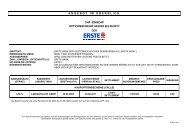GB00_erste lage_E - Erste Group
GB00_erste lage_E - Erste Group
GB00_erste lage_E - Erste Group
Create successful ePaper yourself
Turn your PDF publications into a flip-book with our unique Google optimized e-Paper software.
Principles<br />
of Consolidation<br />
Accounting policies<br />
All significant subsidiaries which are controlled by <strong>Erste</strong> Bank AG are included in the Consolidated<br />
Financial Statements. Significant investments of between 20% and 50% (associates) are stated at<br />
equity and, where necessary, the corresponding financial statements have been restated according<br />
to IAS. As for investments in the insurance sector, owing to the special national legal requirements<br />
and the fact that insurance companies in Austria are not yet reporting according to IAS<br />
these are stated at equity pursuant to local accounting standards.<br />
The remaining investments are reported at cost and in the case of permanent impairment of<br />
value the asset is written off accordingly.<br />
Capital consolidation is done according to the purchase method by setting off fair value against<br />
the parent company’s interest obtained in the equity stake at the time of acquisition. Any difference<br />
between fair value and the equity stake is either partially or completely attributed to the<br />
assets of the subsidiary. Goodwill resulting from acquisitions after 1 January 1995 is capitalised<br />
and written off over its estimated useful life. This is generally set at 20 years for domestic banks<br />
and financial service providers, at 15 years for foreign banks and financial service providers and<br />
between 5 and 15 years for all other companies (see Note 6 Intangible fixed assets).<br />
Intercompany balances, income and expenses as well as intercompany profits and losses are<br />
eliminated provided they are not of minor significance.<br />
1) Loans and advances<br />
Loans and advances to credit institutions and customers are reported at their nominal amount<br />
or at cost.<br />
Provisions for specific and country risks are not set off against the corresponding loans and<br />
advances, but rather reported as a separate line item in the Balance Sheet.<br />
Premiums and discounts—the differences between amounts paid out and nominal amounts—<br />
are reported as interest income or interest expense under other assets or other liabilities, and<br />
attributed to the accounting period in which they are earned or incurred, respectively.<br />
Interest receivable is not recognised as revenue in the Income Statement if—regardless of<br />
the legal right to do so—it is highly improbable that future economic benefits will flow to the company.<br />
Securities not listed on the stock exchange and credit substitutes evidenced by certificates<br />
are reported under the appropriate securities portfolio item (trading portfolio, investments available<br />
for sale or financial investments).<br />
<strong>Erste</strong> Bank 2000 77



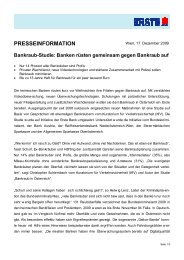
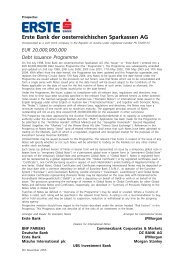
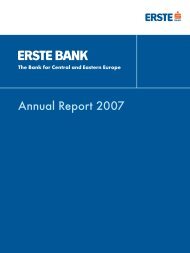



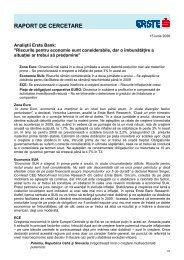
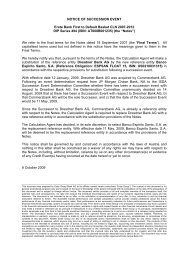

![Fact Sheet Erste Campus [pdf; 181.2 KB] - Erste Group](https://img.yumpu.com/3839392/1/184x260/fact-sheet-erste-campus-pdf-1812-kb-erste-group.jpg?quality=85)
